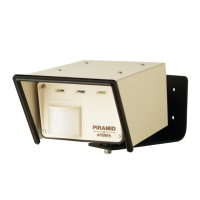
Do you have a question about the protech PIRAMID XL2 and is the answer not in the manual?
Section for recording sensitivity, range, and immunity settings.
Detailed numbered steps for installing the PIRAMID XL2 sensor.
Explains the dual technology and "And Gate" operation of the PIRAMID XL2.
Details electrical, environmental, and coverage specifications for the sensor models.
Covers wall and pole mounting, and best location selection.
Details wire size, terminal strip connections, and cable routing.
Explains how to use the built-in LEDs for walk-testing.
Provides tips for effective walk-testing, like using the sounder.
Describes how the range control adjusts detection area size.
Explains how the sensitivity switch affects alarm trigger movement.
Details sensitivity levels, movement requirements, and critical adjustments.
Explains the two-position switch for immunity to small animals.
Step-by-step guide for using PIR and Microwave LEDs during walk-testing.
Instructions for installing and using the optional XL-Sounder.
Details using the XL-Sounder for efficient walk-testing.
Steps to plug in the XL-Sounder accessory.
Explains the three distinct sounds indicating alarm states.
Advises using the sensor for volumetric motion detection, not perimeter fencing.
Recommends solid mounting surfaces and avoiding vibration.
Advises keeping garbage away from the sensor's field of view.
Warns against aiming the sensor at moving fan blades.
Advises mounting the sensor away from potential perching spots.
Recommends patching fence gaps to prevent animal entry.
Discusses mounting height considerations for detecting small animals.
Explains the use of Pet Alley lenses for animal immunity.
Advises against mounting under non-guttered eaves due to rain runoff.
Warns about detecting large objects like vehicles at long distances.
Ensures each sensor is on its own alarm zone for easier troubleshooting.
Confirms proper input voltage by checking the Voltage OK LED.
Highlights the critical role of sensitivity settings for false alarm rejection.
Explains that the range switch adjusts the detection area size.
Checks if the sensor is angled downward to keep coverage within the area.
Reviews mounting height or Pet Alley lenses for small animal detection.
Addresses issues where the sensor has no power or activity.
Guides on what to do if the alarm LED stays on constantly.
Helps resolve issues with not achieving the sensor's full detection range.
Provides solutions for frequent false alarms.
Illustrates the procedure for changing the lens module.
